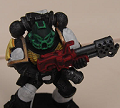 snooggums wrote:
snooggums wrote:There isn't any hole in the rules.
If there is an attempt to act, such as a model shooting (
pg 12), a unit declaring a charge (
pg 20), a unit firing Overwatch (
pg 21), or or fighting in close combat (
pg 23) the unit or model checks for whether it is locked in combat.
The rules state that the
unit cannot
declare a charge if they are locked. Once the unit has declared the charge and they are eligible to declare the charge, you follow the charge rules. There is no direction given to check for locked in combat while moving models in that unit.
When the unit being charged decides to fire Overwatch (immediately after the charge is declared) the
unit that wants to fire Overwatch must check to see if they are locked in combat. If they were charged by another unit previously and are now in base to base as a result of the first charge, the unit cannot fire Overwatch.
Since the rules do state when to check for locked in combat, the statement on page 23 about not being able to move in the subsection titled 'Who can fight' is simply clarifying that once the unit is in combat they can not make the moves as listed.
So:
Unit A declares a charge on unit B. Unit A checks for LIC and charges if they are not (
pg 20).
Unit B may choose to fire Overwatch or not (
pg 21).
Unit A reaches Unit B, there is no direction to check LIC during the charge or after so no check is necessary.
Unit C declares a charge on Unit B. Unit C checks for LIC and since they are not, they may declare the charge (
pg 20).
Unit B chooses to fire Overwatch on Unit C. Unit B check for LIC (
pg 21), and since they are LIC with Unit A they may not fire Overwatch at Unit C.
Combat is fought after checking for eligiblity based on LIC (p23).
The rules already state when to check for locked in combat, based on the actions declared or action taken by the unit. There is zero reason to continue this thread with speculation that a single line taken out of context invalidates the rest of the rules.